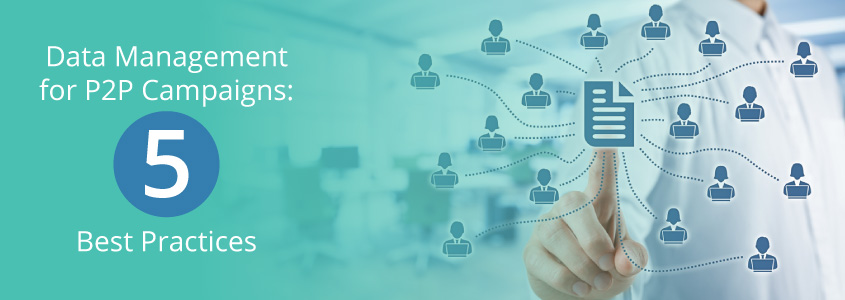When you think of peer-to-peer fundraising, what’s the first thing that comes to mind? It’s probably something along the lines of, your supporters raising money on your behalf. While this is true and serves as the foundation of peer-to-peer fundraising (hence the name) there’s another component that needs some attention.
We’re talking about data management.
The phrase “data management” might make some nonprofit professionals feel a bit intimidated, but it’s something that your organization absolutely needs to focus on. Following data management strategies and incorporating them into your peer-to-peer campaigns can actually maximize your fundraising potential as well as the level of engagement you have with your supporters.
You’re already working with participants in your P2P campaigns, offering them ongoing support, and giving them the tools and resources they need to be successful. So how does data tie into all of this? We’ll be discussing some data management best practices that can help you make the most of your current and future P2P campaigns.
More specifically, these best practices include:
When you take a closer look at your supporter data and past campaigns, these can better inform your future decisions. Are you ready to take a deep dive into these data management strategies? Let’s get started!

1. Use your CRM.
Every nonprofit needs to organize its supporter data, and using a constituent relationship manager (CRM) is the most impactful way to do this. Your CRM is the central location for all of your collected supporter data, such as contact information, donation history, and engagement histories.
According to these peer-to-peer fundraising best practices by OneCause, it’s helpful if your P2P software integrates with your CRM, as this can streamline much of your data organization process.
For example, integrating your fundraising and donor engagement tools will then allow you to:
- Let data flow from your P2P platform into your database, which limits the amount of data your team will have to manually enter (and reduces human error!).
- Let your team work from one connected interface instead of multiple platforms that operate independently of one another.
- Track specific pieces of supporter data so you can personalize your outreach to them (more on this later!).
- Track how you’re interacting with supporters to ensure you maintain an active relationship with them. This will especially come in handy when it’s time to recruit supporters for your next P2P fundraiser.
A robust CRM solution can help you keep track of those participating in your P2P campaign, personalize your outreach, and reduce human error. Just as you would when looking for prospective donors, keep your data clean and organized to make sifting through the information that much easier.
If you’re looking to upgrade your donor database system or want more insight, check out this list of top CRM software.

2. Use data to incentivize.
One of the more exciting components of peer-to-peer fundraising involves gamification. According to OneCause, leaderboards and fundraising thermometers can inspire participants to go even further.
It’s clear you can use gamification as a way to encourage friendly competition among your participants, but how can you leverage the data that comes along with it?
In order to make the most of your data and incentivize your participants to keep going strong, you can follow these steps:
- Look at your milestone badges and determine how many participants are actually reaching them.
- If you see that many participants aren’t reaching your lowest tier, consider adjusting your communication methods or adding additional incentives to encourage participants to reach their goals. The more your participants achieve these tiers, the more motivated they will be.
- If you find that a large number of participants are surpassing your lowest tier, you could try raising it. Encourage your participants to push themselves even further to reach a higher-placed tier.
By properly leveraging your data, you can encourage your P2P participants to up their engagement level and simultaneously inspire them to work even harder when they reach these milestones. It’s all about putting their hard work on display and recognizing them for it.

3. Use predictive analysis.
When it comes down to analytics, there’s one type in particular that applies directly to peer-to-peer fundraising: predictive analytics. Predictive analytics takes the data you’ve collected on your donors and makes an attempt to predict their future behavior. This is done by finding patterns and trends in your fundraising data.
So how does this apply to P2P?
Here’s how you can use predictive analytics to determine how likely each constituent in your CRM is to participate in your P2P campaign.
- Collect the information you have, such as each supporter’s name, contact information, and giving history.
- In addition to this information, gather data on these constituents’ social media activity, education, wealth, philanthropy, and more.
- Using data that’s readily available about P2P supporters and participants in general, determine who in your database is most likely to participate.
- Use your findings to target the right people and make decisions about who to contact.
In addition to this, you should also review your fundraising revenue in relation to the types of participants. A lot of the time, those who raise the most money make up a small percentage of your participants. While all of your participants are important (and you should engage with each of them!), it may be beneficial to recruit more of those types of high-performing people.
There are a lot of valuable analytics you can measure using the information stored in your CRM—you just need to know what you’re looking for!

4. Enhance your events.
Many peer-to-peer fundraisers culminate in an event, which means there’s a lot of data you can use to improve future ones. By determining where your past events have gone well and where there is room for improvement, you can enhance your next big engagement.
Try out these strategies to manage data for your events:
- Measure the number of supporters who attended your previous event. This will help you determine if your event type appeals to a large number of people or if you need to vary your strategies a bit.
- Analyze gift sizes. Take a look at the gift sizes you received at your event and what these gifts were given to, so you can repeat the most popular offerings at future events.
- Look through your CRM for feedback received through surveys or collected in person to determine areas where you can improve as well as learn what went well.
- Measure the smaller things. Was there enough parking? Enough food and beverages? Make sure you take into consideration all elements that can impact your participants’ enjoyment of the event.
Take advantage of the data you have available from the past. By improving your events based on this information, you’ll encourage more participation, bring in more donations, and successfully engage your donors.

5. Personalize your outreach.
As mentioned earlier, data can help you personalize your outreach to potential P2P participants. By drawing on past campaign information, you can customize your next recruiting email based on the audience of the email recipient.
For example:
- For past participants: Look up your past participants’ results and say something like, “Thank you for raising $X during our campaign last year!” This personalization will demonstrate your appreciation of their commitment and encourage them to participate again.
- For past supporters: Reach out to past supporters and explain how much your participants helped raise with their donations. Be sure to include impact information! The 2022 Giving Experience Study reported that showing impact is a top giving motivator for P2P donors.This can help convert supporters into participants and transition them from givers to active fundraisers.
- For past sponsors: Use your CRM to tailor outreach to your sponsors and explain how much of an impact their sponsorship made.
- For potential new participants: You could say something like, “We raised $X last year as a result of our X awesome fundraisers. Want to help us reach this year’s goal?”
Using the data you have readily available offers a more compelling reason for people to get involved in your P2P campaign. By adding this data from past initiatives, you’ll motivate more people to get involved and raise even more. Your campaign always has the chance to go viral, so be sure you’re giving it the boost it needs.
Get specific as well, explaining what the money you raised went toward and how that money has impacted your cause and your beneficiaries. After all, just as donors want to know how their gift is used, P2P participants want to know where the money they’re raising is going. Keeping them updated on that progress is a great way to keep them engaged!
Data management may sound daunting, but with the right resources and approach, you can leverage it to your full advantage. This is especially true with peer-to-peer fundraising because you can enhance and improve your campaigns based on the data you collect from your supporters and your overall initiatives.
By leveraging your CRM data to personalize your outreach, incentivize your supporters, enhance your events, and more, you can raise even more funds and keep the momentum going with your cause. Be sure to incorporate these best practices and stay on top of your data.
About the Author: Sarah Sebastian, Director of Corporate Communications at OneCause

She’s a marketer and brand geek at heart with eight years of experience in the nonprofit tech space. Outside of work, Sarah can be found reading, hiking, kayaking, volunteering for Florida Access Network, or getting lost in the woods while photographing birds.



